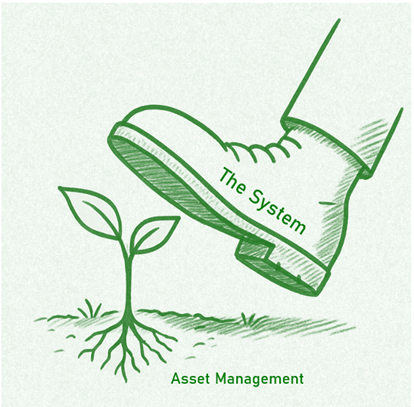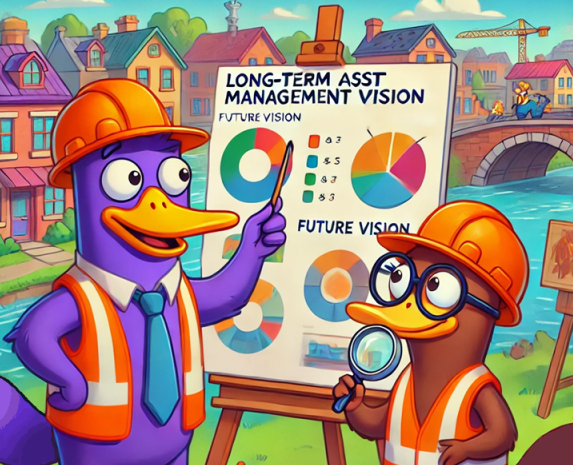
ID 26212151 | Child In Shallow © Pavla Zakova | Dreamstime.com
When we look back at the history of Asset Management, there is one curious feature.
In a world in which many people go on about data, many act like the revolution of AM is the discovery of asset data.
Why?
Penny many years ago made the point – well, that the point is making better long-term decisions about assets. Wave 1, ‘asset inventory’, only has any value when we use such data to make better decisions, in Penny’s Wave 2: strategic asset management. As Penny says, when you focus on the decisions, you have a much clearer idea of what data you actually need. Wave 2 improves Wave 1.
But there must be some kind of reason why organisations seem to have to go through Wave 1, collecting and organising data, first.
Cynically, we might think it’s because it’s easier than questioning decision-making: something middle level asset managers can do without challenging business at the top level. Or, and/or, there are plenty of suppliers willing to sell you help in collecting data or implementing the transactional IT systems to put it in. Few that actually know how to make better decisions.
But I come to suspect that, weirdly, asset-centric data is more radical than it sounds. What suggests this is how hard other teams kick and scream about collecting and handing on asset inventory, the very basic data on what assets we have where. (Capital projects, IT, even some maintenance teams.)
It doesn’t seem to help to stress that we cannot manage what we don’t know we have. Is the problem that they don’t understand that we do have to continue to manage assets into the future?
Or is it – back to basics – that the whole concept of an asset is the first revolution?
Other people manage projects, budgets, sites, even value on the balance sheet. Only Asset Management believes the fundamental unit of management is the operational asset.
Can we rewrite the advice on implementing Asset Management to get us to decisions faster?
Are too many organisations still not making that very first leap into the water?

I always taught that the international standard ISO 55000 was a milestone achievement for the profession of Asset Management when it was published in 2014. A consensus across many sectors and countries, when it’s clear not everyone sees the same things in AM.
It’s really about AM as a quality management system – do what you say, say what you do.
And it does acknowledge the issue of senior management, the decisions makers – the importance of leadership actively supporting the management system.
However, plenty of organisations have not felt a great need to be certified against it, even if it addresses basically sensible management practice.
I want to think about two aspects of this.
First, they don’t need certification because it’s not anything they feel especially held accountable for. A couple of bodies, such as Ofgem the UK power regulator, have considered making it a legal or licence requirement, but have been resisted.
Second, even if it were in some way enforced, it doesn’t address big decisions. Somehow, it doesn’t say anything about how an organisation, or a government, decides to spend millions on an infrastructure project – how to avoid wasting the money, or anything they should do after they have a failed project on their hands. It doesn’t really address budgeting at all.
It’s pitched at middle management processes. Yes, lower asset decisions need to be aligned with overall organisational goals – and in some way signed off by top management.
But about the decisions top management makes itself, not so much.
I am not asking for an amended standard in ISO terms. More something like higher standards in public service (and infrastructure is always a service to communities, even when controlled by commercial companies).
What should we do instead, in addition?
- How to get the organisations themselves to think more carefully about their big, long term decisions – it that possible through internal audit-type mechanisms? (Such as, are they following their own asset strategies and long-term planning and budgeting processes?)
- And how much do we, the public, need more formal mechanisms like third party audits, and tougher regulators, to hold them accountable for how they make the big money infrastructure decisions?
What can we, as Asset Management professionals, as middling managers, do about this?

39167631 | Cartoon Teeth © Tigatelu Dreamstime.com
Why do so many organisations not have good long term plans for their assets? Why don’t they stick to their Asset Management strategies?
Being continually sucked back into short term reaction is one problem for infrastructure (and the more political the sector – such as transit – the worse it is).
And forgetting. New CEO, new CFO, someone coming in that simply hasn’t thought about what they are managing. Good Asset Management isn’t built into the furniture, the basic business processes enough. Someone ignorant of AM comes in and doesn’t even know what they are abandoning.
The need for tighter regulation may be, as Lou Cripps has said, just evidence that a sector isn’t doing a good job.
But I am coming to think that mandatory audit – as in government audit offices, or even internal audit enforced by non-executives as part of good governance – may be a key infrastructure AM tool.
Infrastructure, managed on behalf of communities, is too important and too long term not to manage well. Decision makers – whether C suite, councillors, board members – must be held to account for their decisions.
Regulated audit is one practical way to do this. Not simply the kind of quality control envisaged in ISO 55000, more the kind of visibility (and check for legality) of an annual financial audit. Not perfect, but a lot more companies would cheat on their tax without it!
Audit is not judging by results, but checks you did what you said you would do, that you followed the processes that you claim to use. Such as evidence-based budgeting and business cases for investment.
A good decision can still lead to less than good outcomes – but making it well is all we have for the long term.
Scrutiny of the process is particularly important when making decisions for the long term. This requires clarity and sticking to your principles. Being able to demonstrate you know why you made a decision.
I suspect audit with teeth is a natural companion to good longer term, more strategic thinking about our physical assets.
What is your experience of regulation audit in Asset Management?

ID 48941664 | Crumbling Wall © Pzaxe | Dreamstime.com
Talking Infrastructure has been discussing why organisations do not make better use of longer-term Asset Management Plans (the AMP).
One challenge we have identified is that the decision makers – in the C suite, council, board – are not promoted for their ability to make tough decisions, but for their skills at keeping people happy.
I have nothing against informed compromise: after all, good practice Asset Management depends on trade-offs. On balancing performance, cost and risk, short term and longer term, different kinds of service against each other.
But do many senior decision makers feel that facts may hamper their room for negotiation?
The ‘fact’ we’ve discussed is not pulled out of big data, but the reality that assets wear out, or otherwise have time-limited lives.
Penny Burns’ original lifecycle model was focused on estimates ( from SME and local experience) of when we ought to replace assets. You might argue about the exact date, of course, and there’s room for investigation of optimal costs. But in practice executives don’t generally deny that things need replacing – if they think about it.
What I feel happens is the people who make the budgets try not to think about it, because that’s largely in the future. There are enough immediate problems!
Our experiences suggest executives understand there will be future costs, and risks, if this is put before them. A good graph of risk against expenditure, or a summary of replacement peaks and troughs for the next twenty five years.
One challenge is whether there is anyone to continue to put this in front of them. And in front of the next CEO or CFO or council members, when they come in not thinking at all about the fact the physical assets will need action, sooner rather than later, and someone has to think ahead about the money and resources to carry them out.
Because thinking about it might force hard choices – like to increase budget or lower standard of service.
What are you experiences with promoting the longer-term, lifecycle understanding of physical assets?
Does regulation and audits on AMPs help?
My last post examined Thomas Kuhn, who gave us the language of paradigm shifts, here, I’d like to look at a book by Michele Wucker* who gave us the image of the Gray Rhino: a massive, obvious threat we can see coming but still fail to confront.

Where Kuhn focused on how systems break and are replaced, Wucker draws attention to the crises we recognize but still choose to ignore.
Asset Management exists at the intersection of these two frameworks.
Asset-intensive organizations are surrounded by gray rhinos. Infrastructure gaps, aging systems, climate vulnerability, workforce attrition, regulatory pressure: these are not surprises. They are slow-moving, well-documented challenges that, if left unaddressed, will overwhelm the system we rely on.
Yet for all their visibility, these threats rarely trigger the level of change they demand. Instead, they are absorbed into routine. Budget cycles roll forward. Work orders are prioritized by urgency rather than consequence. The language of Asset Management is invoked, but its paradigm is never fully adopted. We name the problem but struggle to act on it.
Asset Management offers an approach precisely designed to engage these looming risks. It asks us to plan, to prioritize, to see beyond the emergency response. It invites organizations to realign their values, moving from reactive service delivery to deliberate, long-term stewardship.
But as Kuhn would note, this requires a change in the underlying logic, a shift in how organizations understand value, success, and time.
Until that shift happens, Asset Management remains vulnerable to reinterpretation. The system continues to operate within the old paradigm, where short-term efficiency trumps long-term value, and where the urgency of today erodes the preparation for tomorrow.
This is not a failure of awareness. It is a failure of transformation. We see the gray rhino, and we have a framework for responding to it. But our systems, both technical and cultural, are still optimized for a different reality.
So, what do we do with this tension?
We start by recognizing that paradigm shifts don’t come from force. They come from readiness.
And readiness grows in moments of discomfort, when the cracks in the current system become too wide to ignore. When organizations feel the weight of the gray rhino pressing closer, they become more open to doing things differently.
Asset Management must be positioned as more than a practice. It must become a way of seeing the world around us. Using a lens where the familiar takes on new meaning and is a guide for what to do when the warning signs are no longer abstract.
Most importantly, Asset Management needs its champions. People who can not only name the gray rhino and frame the conversation but offer a path forward that is both pragmatic and bold.
Change can be slow, but it is also inevitable. Those that prepare will be the ones best positioned when the shift finally takes hold.
The gray rhino is here. The question is whether you will continue to ignore it or finally take action to avoid being trampled.
*The Gray Rhino: How Recognize and Act on the Obvious Dangers We Ignore, Michele Wucker, 2016
This is a follow-up to Julie’s and my first post. This comes from discussions with Ruth, as we are both fans of Kuhn and approaching Asset Managment from a Systems Thinking bend.

Asset Management isn’t failing, but it is struggling. It’s struggling because it asks for something most organizations aren’t ready to give: a change in worldview.
In his seminal work The Structure of Scientific Revolutions, Thomas Kuhn argued that progress in science doesn’t move forward in smooth, logical steps. Instead, it lurches forward through upheaval.
An existing model, what Kuhn calls a paradigm, organizes how people understand and act in the world. When that model starts to break down under the weight of anomalies it can’t explain, a crisis forms. Eventually, a new model takes hold. Not by refining the old one, but by replacing it entirely.
Asset Management isn’t a toolkit upgrade. Asset Management is a paradigm shift.
The prevailing paradigm in many organizations see assets as cost centers. Value is measured in terms of budget variance, performance is gauged by how fast we respond to failure, and success means keeping operations running despite broken systems and shrinking resources. This is the logic of firefighting, not foresight.
Asset Management offers a radically different frame. It suggests we treat assets as value-producing systems. These decisions should be based not only on today’s conditions but on long-term impacts. That success means reducing failure, not merely reacting to it quickly. And that the ultimate responsibility of an organization is to deliver reliable, sustainable service—not just to manage budgets.
But here’s the problem, and Kuhn would recognize it: paradigms don’t go quietly. The existing mindset fights back. Asset Management is often taken in and translated through the old lens. We say we’ve adopted Asset Management, but we’re still rewarding short-term fixes. We talk about lifecycle value, but we still plan one year at a time. We build dashboards and risk models, but we still defer investment until failure forces our hand.
This is normal. According to Kuhn, when a new paradigm first appears, it doesn’t make sense within the old logic. People struggle to see its relevance. They may accept some of its tools, but not its worldview. The old questions remain, and the new answers seem off-topic.
Real change happens only when the organization starts asking new questions. Not just, “How do we save money this year?” but “What will this decision cost us over the next 30?” Not, “How fast did we respond to the outage?” but “Why did the outage happen at all?”
That’s when a shift begins.
A true Asset Management transformation doesn’t begin with data, or systems, or even leadership mandates. It begins with discomfort, when the old paradigm can no longer explain the failures piling up around us. When firefighting becomes too exhausting, too expensive, too visibly ineffective. Then, and only then, do people become open to a new way of thinking.
So, the task isn’t just to implement Asset Management. It’s to create the conditions where the old worldview can be questioned. That means:
- Telling stories that expose the cost of reactive practices
- Measuring success in ways that reward foresight
- Giving voice to people who see the long game
- Protecting Asset Management from being reinterpreted as just another compliance exercise
Paradigm shifts are hard. They are political, cultural, and emotional. But they are also the only way real progress happens. Asset Management doesn’t need to fight harder. It needs to be ready to lead when the cracks in the old system finally become too big to ignore. It needs to be there to offer a better forward.
Link to Ruth’s article: AM, Capital-ism and Shifting Paradigms | Talking Infrastructure
Julie and I produced this after a recent discussion with Ruth. I think it’s a discussion we’ve been having for years.

Todd Shepherd & Julie DeYoung
Once upon a time, or so the story goes, Asset Management started to take sprout at our organizations with a bold promise. It came to guide us toward long-term thinking, to help us look beyond next year’s budget and into the decades ahead. It came with principles and frameworks, a philosophy that assets are not isolated items, but interconnected parts of a whole. The decisions we make today shape the quality of life for future generations. It was a different way of seeing how investing in the right place, at the right time, could save money, and public trust.
But then Asset Management met The System. And The System did what it always does: it absorbed the new idea and bent it back into something familiar.
Instead of being a strategy for long-term stewardship, Asset Management became a new label for what we were already doing. We turned it into a more refined version of the same habits: squeezing the last bit of life out of aging assets, reacting quickly to failures, and deferring investment until the next crisis hit. We framed these actions as efficiency, as cost savings, as smart business. But they were just survival tactics. And so, when Asset Management started to bloom, it was quietly, subtly, reshaped.
What was meant to be transformational became transactional.
Long-term planning? That would have to wait. We needed to fix the latest failure, explain the recent cost overrun, patch the emergency before the news cycle caught wind. The capital planning calendar was full of yesterday’s fires. Asset Management was drafted into service as a better way to react.
Rather than change The System, Asset Management was absorbed by it. It was translated into the language of short-term cost savings and immediate returns. “Get more life out of your assets” became a directive, not to optimize lifecycle value, but to defer replacement as long as humanly possible. And The System applauded. Budgets tightened. Work orders increased. Failure response times improved…until they didn’t.
This isn’t a failure of individuals. It’s what happens when a new idea runs headlong into The System. The System reward firefighting over fire prevention. It promotes leaders who solve today’s crises, not those who quietly prevent tomorrows. It allocates resources to what is visible, immediate, and politically expedient. And so, Asset Management is quietly reshaped until it fits.
A discipline focused on resilience and long-range value becomes a sophisticated way to do what we’ve always done: squeeze, stretch, defer, and repeat.
Asset Management, instead of being a disruptor, became domesticated.
The truth is, Asset Management requires a paradigm shift. It requires a new way of thinking about value, responsibility, and time. It asks us to see past short-term wins and start building for long-term resilience. It asks leaders to stop managing symptoms and start addressing root causes. It asks organizations to measure success not by how fast they respond to failure, but by how rarely failure occurs at all.
That’s a hard shift to make. It means unlearning habits, changing incentives, and having the patience to invest in what won’t pay off this quarter. It means making space for new voices, new metrics, and sometimes uncomfortable truths.
But if we want Asset Management to be more than a buzzword, we need to protect it from the status quo. We need to give it space to grow before we ask it to perform. And most of all, we need to let it change us before we change it.
To do that, leaders must become designers of systems, not just managers of outcomes. They must ask: What behaviors are we rewarding? What stories are we telling? Are we building a future, or just managing decline?
Asset Management didn’t fail. It simply wasn’t given a chance to take root. But the story isn’t over. It’s still being written. And if we’re willing to change the system, we might just change the ending.

Image from James Webb Telescope: Interacting Galaxies
After taking three months off – impressed how much surgery slowed me down! – I am taking stock.
I find I am almost totally not interested in Asset Management as a technical subject. Or rather, that I have no hope that something technical (like ‘AI’) will sort it for us.
And yet, there is still a large problem to be sorted, that surely requires new, and clever, thinking.
The Talking Infrastructure board is more or less convinced that we have not yet made Asset Management stick. In particular, to get where Penny saw 40 years ago: business as usual longer term planning to meet infrastructure demand. And more recently, planning ahead in a changing world.
One painful example is the retreat from meaningful AMPs in Australian councils, their first home.
Why infrastructure organisations don’t face the future has been a puzzle. Vested interests, for example in the construction industry, sure; lack of skill or vision in the decision-makers, yeah. Is it basically that the pain of not planning adequately doesn’t fall on the people failing to plan?
Our inability as a species to think beyond a few years?
But I am not yet that pessimistic. I don’t believe it’s biological.
What most grips me is the problem of culture. Yes, we happen to live in a peculiarly short-termist culture. But let’s, as clever people, tackle it as a Meadows-type system challenge.
In the past decade some of us have asked how we can get an organisation to plan sustainably: to have a process, a system to plan out our assets, that outlives any CEO, or any individual asset manager for that matter. A few years ago, a network of us in North America looked at how to ensure that an incoming CEO took an AMP process as given. Useful and entrenched enough not to be their focus for change.
Did we succeed anywhere?
Watch this space…

From script by Lou Cripps
What’s the responsibility of Asset Management? In my mind, there’s no question.
The output from an effective Asset Management system is a better allocation of resources to physical assets. It’s all about allocating $ and people where they are most needed, and not to spend or do where that is not needed.
And that can mean only one thing. AM – the system, not the team – should be the major input to the budgeting process for asset-intensive sectors such as power. And a major input wherever there is a significant amount of budget at stake.
The Asset Management input to the budgeting process is what Penny originally called the AMP. Given that ISO 55000 didn’t quite get it, I wonder if we should now spell it out – the asset management planning process (AMPP). One integrated, co-ordinated process that looks across the whole asset base with consistent principles on which to base decisions about priorities for the medium and long term.
We should expect – hope, indeed! – that this will over time have a major impact on business budgeting. That asset-related budgets will change significantly when we have a more optimising system, to make better use of information and plan further into the future.
The focus is not individual decisions, but the wider decision processes.
- What are the priorities for asset renewals, that is major work to replace or refurbish assets?
- What is the appropriate level of planned maintenance to optimise cost, risk and performance?
- Given the current state of the asset base, what is a realistic level of allocation to reactive work going forward?
- How do any growth or new assets fit within the overall strategy (and how important are they in relation to sustaining the assets/ services we already have)?
And this is not planning just about the physical assets. Both the money and the resources have to be considered: there is little point in arguing for money if there is not also a realistic plan for the people to deliver the work.
If we agree this is what Asset Management has to deliver, that also tells us what the main job of a dedicated AM function is and its key relationships with other functions. We can work through what kind of skills and capabilities we require, and where AM sits in the organisation.
It’s why I don’t consider Asset Management in any sense a sub-branch of Engineering – or the capabilities what we teach on current engineering degrees. It’s also not Finance, or HR, or Procurement, though it involves all of these.
And the bigger the amount of dollars at stake, the more vital that we do good Asset Management.
Talking Infrastructure is looking again at the AMP and the asset planning we require for future-friendly infrastructure. If you would like to be involved, contact us!

From script by Lou Cripps
Sometimes, it feels too much to do it all step by step.
Most organisations I work with don’t yet have any asset plans beyond five years. Some still only have annual budgets. How do you add in changing requirements for the longer term if you don’t even ask past five years?
And how many years ago did asset managers realise you can’t plan if you don’t think about where you want to get to? (At least 20, because strategy comes before planning in BSI PAS-55 published in in 2004.) But almost no-one has properly strategic ‘asset strategies’. They literally don’t know where they want to take their assets.
Bit by bit – and maybe getting nowhere fast.
But there is an alternative, maybe. Can we describe a compelling vision of where we want to be, first?
Can we even leapfrog some of the gradualist things we currently do?
Gradualism may be personal preference, or professional training. We haven’t always been bold about our mission. Some of us are detail people.
How would it be if we really believed we have a duty of care to make a big difference to the, frankly, fairly dumb way we’ve conventionally managed infrastructure?
Todd Shepherd and Julie DeYoung describe this as a system thing. What we have is a system, or paradigm, which resists change – so tinkering at the edges doesn’t work, because the old system will just bounce back as soon as you stop pushing.
This is, of course, quite a different concept of ‘system’ from the parts and pieces idea of a ‘quality management’ approach such as ISO 55000, which instead encourages a bit by bit, start with AM policy or SAMP. Better than thinking the first step has to be IT – but possibly no more ‘sticky’.
Quicker, and less heartache, to go for undermining the whole thing with strategy and long-term planning from the start?

Recent Comments